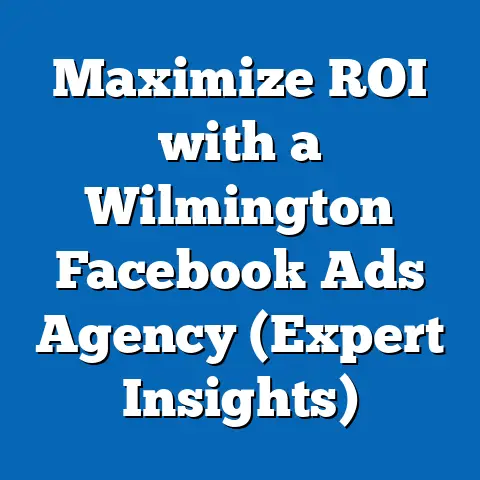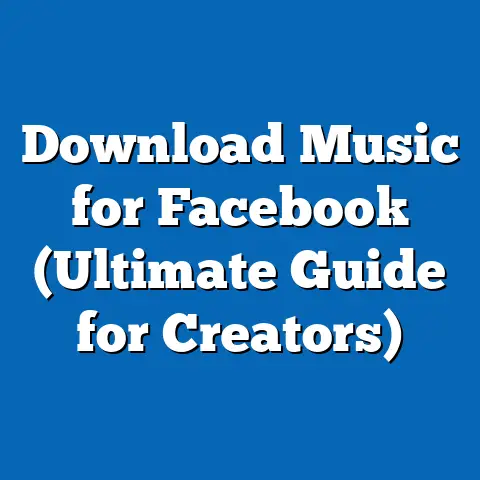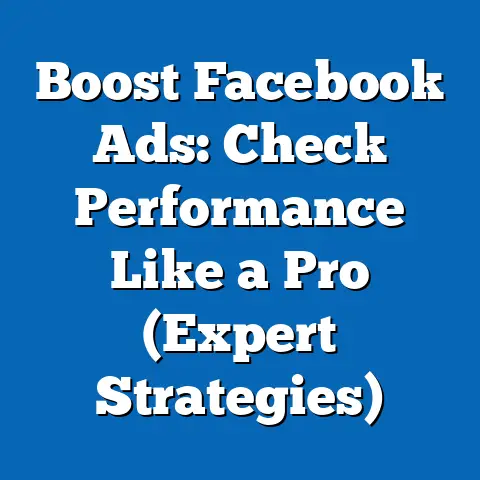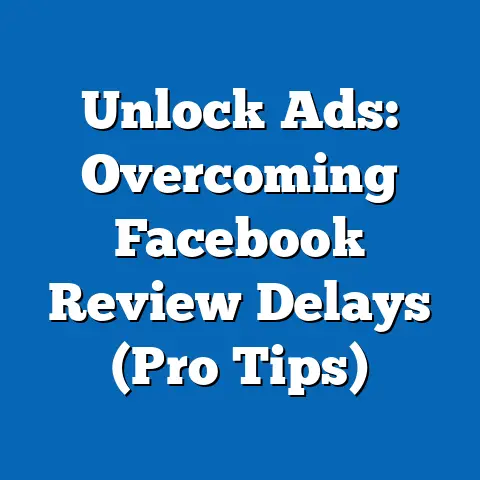Master Facebook Ad Cancellation (Proven Strategies Unveiled)
Facebook ads can sometimes feel like that one persistent friend who just doesn’t get the hint. You’ve scrolled past their posts a million times, yet they keep popping up. As marketers, we’ve all been there – staring at underperforming Facebook ads, wondering when to pull the plug. But ad cancellation doesn’t have to be a dreaded task. In fact, when approached strategically, it can be a powerful tool for optimizing your campaigns and boosting your overall ROI. I want to walk you through the ins and outs of Facebook ad cancellation, sharing proven strategies that will help you make informed decisions and turn potential losses into opportunities for growth.
Understanding Facebook Ad Cancellation
Facebook ad cancellation, at its core, is about making the conscious decision to stop running a particular ad or ad set within the Facebook Ads Manager. This can involve pausing an ad temporarily or completely shutting it down. I think of it as a necessary form of digital housekeeping.
But why is this even important? Why not just let ads run their course? Well, understanding when and why to cancel ads is crucial for several reasons:
- Budget Optimization: Nobody wants to waste money on ads that aren’t delivering.
- Performance Improvement: Canceling underperforming ads allows you to focus resources on what’s working.
- Strategic Alignment: Business goals evolve, and your ads need to keep pace.
I remember early in my career, I was hesitant to cancel any ads, thinking that more exposure was always better. I quickly learned that quality trumps quantity every single time. It’s about being smart with your spending and ensuring every dollar contributes to your desired outcome.
Common Reasons for Ad Cancellation
So, when should you consider hitting that “pause” or “delete” button? Here are some of the most common reasons I’ve encountered over the years:
Poor Targeting and Audience Engagement
This is a big one. If your ads aren’t reaching the right people, they’re not going to perform well. I’ve seen countless campaigns fail simply because the targeting was off.
- Example: Let’s say you’re selling high-end organic dog food, but your ads are being shown to users who primarily engage with budget-friendly pet products. The disconnect is obvious.
Takeaway: Regularly review your audience targeting. Are you using the right demographics, interests, and behaviors? Are you excluding irrelevant audiences?
Budget Constraints and ROI Concerns
Sometimes, even well-targeted ads can struggle to deliver a positive return on investment (ROI). This could be due to a variety of factors, such as:
- High competition: You’re competing with too many similar ads, driving up costs.
- Low conversion rates: People are clicking on your ads, but not completing the desired action (e.g., making a purchase, filling out a form).
- Inefficient bidding: You’re paying too much for each click or impression.
I had a client once who was running a fantastic campaign, but their cost per acquisition (CPA) was through the roof. We had to make the tough call to pause the ads, reassess our bidding strategy, and relaunch with a more efficient approach.
Takeaway: Don’t be afraid to cut your losses. If an ad isn’t delivering a positive ROI within a reasonable timeframe, it’s time to re-evaluate.
Creative Fatigue or Lack of Innovation in Ad Content
Ad fatigue is a real phenomenon. People get tired of seeing the same ads over and over again, even if they were initially effective.
- Example: Think about that catchy jingle you loved at first, but now makes you want to mute the TV.
Takeaway: Keep your ad creative fresh and engaging. Regularly test new images, videos, and ad copy. Don’t be afraid to experiment with different ad formats.
Changes in Product Offerings or Business Goals
Sometimes, the reason for canceling ads has nothing to do with performance. Your business might be evolving, and your ads need to reflect those changes.
- Example: You’re launching a new product line, discontinuing an old one, or shifting your marketing focus.
Takeaway: Keep your ads aligned with your overall business strategy. Don’t keep running ads for products or services that are no longer relevant.
The Psychological Aspect of Ad Cancellation
Okay, let’s get a bit deeper. Canceling ads isn’t just a logistical decision; it’s also a psychological one. I’ve noticed that many advertisers struggle with the mental barriers involved.
The Fear of Loss
One of the biggest hurdles is the fear of losing potential customers. You might think, “What if that ad was just about to take off? What if I’m missing out on valuable leads?”
This is a classic example of loss aversion – the tendency to feel the pain of a loss more strongly than the pleasure of an equivalent gain. It’s a powerful bias that can cloud your judgment.
Takeaway: Remember that data-driven decisions are key. Don’t let fear dictate your actions. If the numbers are telling you to cancel, trust the data.
The Necessity of Optimizing Ad Spend
On the other hand, you have the responsibility to optimize your ad spend. You can’t afford to let emotions get in the way of making smart business decisions.
I once spoke with a successful marketer who told me, “I treat my ad budget like a garden. I prune the weeds (underperforming ads) to allow the flowers (high-performing ads) to thrive.”
Takeaway: View ad cancellation as a necessary form of pruning. It’s about nurturing your best-performing ads and eliminating those that are holding you back.
Proven Strategies for Effective Ad Cancellation
Now, let’s dive into some specific strategies that can help you cancel ads effectively without negatively impacting your campaigns.
Data-Driven Decisions: The Cornerstone of Success
Before you even think about canceling an ad, you need to analyze its performance metrics. This is where your data skills come into play. Here are some key performance indicators (KPIs) to consider:
- Click-Through Rate (CTR): Are people clicking on your ad? A low CTR suggests that your ad copy or creative isn’t resonating with your audience.
- Conversion Rate: Are people taking the desired action after clicking on your ad? A low conversion rate indicates that your landing page or offer might be the problem.
- Cost Per Click (CPC): Are you paying too much for each click? A high CPC can quickly eat into your budget.
- Cost Per Acquisition (CPA): How much are you spending to acquire a new customer or lead? A high CPA means your ads aren’t cost-effective.
- Return on Ad Spend (ROAS): How much revenue are you generating for every dollar you spend on ads? A low ROAS indicates that your ads aren’t delivering a positive return.
Actionable Tip: Set benchmarks for each KPI. For example, you might decide that an ad with a CTR below 1% or a CPA above \$20 should be considered for cancellation.
Testing and Experimentation: A/B Testing for Clarity
A/B testing (also known as split testing) is a powerful way to identify which ads are performing best. By running two or more versions of an ad simultaneously, you can see which one resonates most with your audience.
- Example: You could test different headlines, images, or calls to action.
Actionable Tip: Use Facebook’s built-in A/B testing feature. It allows you to easily compare the performance of different ad variations.
Gradual Scaling Back: A Gentle Approach
Instead of completely shutting down an ad, consider pausing it gradually. This can help you gauge the impact of your decision and avoid any sudden drops in traffic or leads.
- Example: Reduce your daily budget by 25% each day for a week.
Actionable Tip: Monitor your campaign performance closely during the scaling back period. If you see a significant drop in results, you might want to reconsider your decision.
Feedback Loops: Listening to Your Audience
Don’t underestimate the value of direct feedback from your audience. Ask them what they think of your ads. What do they like? What do they dislike?
- Example: Run a poll on social media or send out a survey to your email list.
Actionable Tip: Use the feedback you gather to improve your ad creative and targeting.
Implementing a Cancellation Strategy
So, how do you put all of this into practice? Here’s a structured approach to implementing a cancellation strategy:
- Create a Checklist for Ad Performance Review: This checklist should include all the KPIs you want to track, as well as your benchmarks for each metric.
- Set Timelines for Regular Ad Evaluations: Decide how often you want to review your ad performance. I recommend doing this at least once a week.
- Establish Criteria for Re-Evaluating Canceled Ads: Just because an ad didn’t work in the past doesn’t mean it won’t work in the future. Set criteria for when you might want to re-evaluate a canceled ad.
Actionable Tip: Use a spreadsheet or project management tool to track your ad performance and cancellation decisions.
Learning from Cancellation
The most important part of ad cancellation is learning from your mistakes. What went wrong? What could you have done differently?
I’ve found that the best way to do this is to:
- Analyze your data: Look for patterns in your data that might explain why an ad failed.
- Document your findings: Write down what you learned from the experience.
- Share your insights: Share your insights with your team.
I once worked on a campaign where we canceled several ads due to low conversion rates. After analyzing the data, we realized that our landing page was the problem. It was slow, confusing, and didn’t clearly communicate the value of our offer.
We redesigned the landing page, relaunched the ads, and saw a significant improvement in conversion rates.
Takeaway: Don’t view ad cancellation as a failure. View it as an opportunity to learn and improve.
Conclusion
Mastering Facebook ad cancellation isn’t about admitting defeat; it’s about making strategic decisions that ultimately lead to better results. It’s about being data-driven, adaptable, and always willing to learn.
I hope this guide has given you the tools and knowledge you need to confidently cancel underperforming ads and optimize your Facebook ad campaigns.
Call to Action
Now, I challenge you to take a look at your current Facebook ad campaigns. Are there any ads that need to be canceled? Don’t be afraid to make the tough calls. Your ROI will thank you for it. Remember, the goal isn’t to run as many ads as possible; it’s to run the right ads. And sometimes, that means saying goodbye to the ones that aren’t working.






